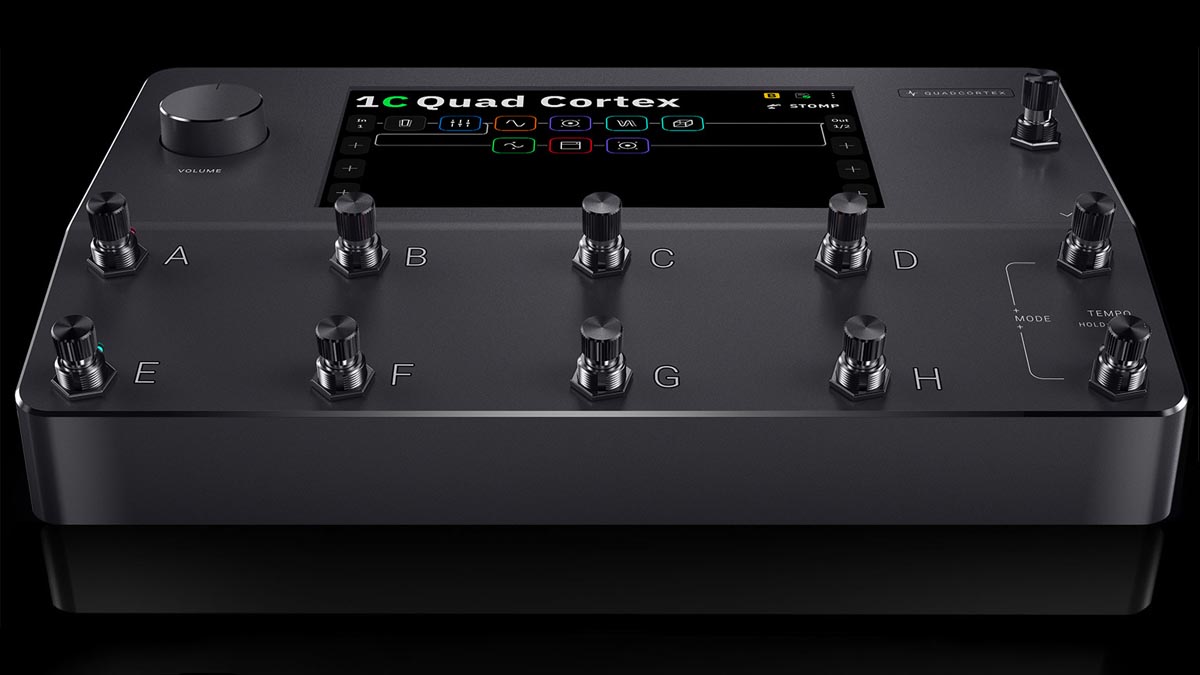GuitarPlayer Verdict
Intuitive, fun, with a clever design, and some exceptional tones, the Quad Cortex is an inspiring product that presents a future for amp modeling units that players of all styles will want to invest in.
Pros
- +
Well made and designed.
- +
Extremely easy to use and program.
- +
And most importantly, it sounds superb.
Cons
- -
Time will tell whether the integral rotary controls/stomp switches hold up on the road, and Neural DSP has yet to release the editor software at the time of writing.
You can trust Guitar Player.
Having forged a stellar reputation in the world of plug-in software, Finnish developer Neural DSP announced its move into amp-modeling hardware more than a year ago, eliciting excitement from a world already enthralled by the works of Fractal, Line 6, Kemper, Atomic, and other amp emulators.
On paper, this excitement was totally warranted, given the Quad Cortex’s promise as “the most powerful floor modeler on the planet.”
That boast encompasses 2GHz of six-core SHARC- and ARM-based processing; more than 50 amps, 70-plus effects, and over 1,000 IRs; 256 factory presets and up to 2,560 user preset slots; amp, cab, and pedal-capture capabilities; comprehensive touch-screen control and editing; and USB audio-interface capabilities, all in a rugged box measuring 11.5 x 7.5 x 2 inches and weighing 4.2 pounds.
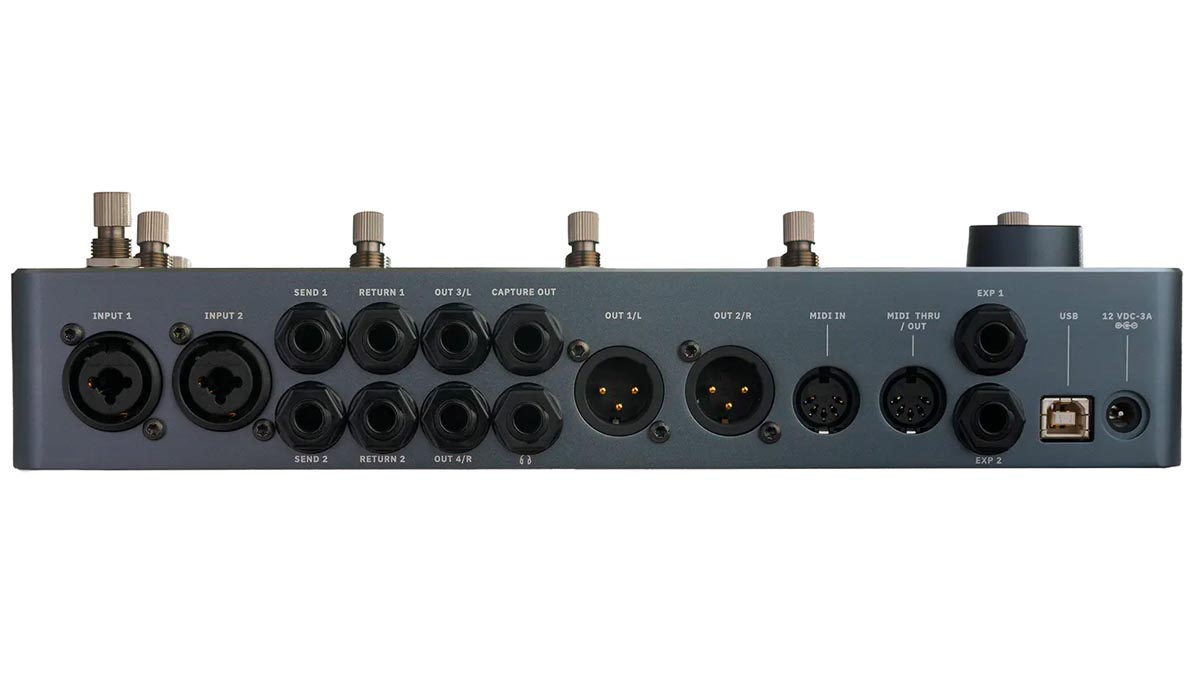
Within minutes of my using it, the Quad Cortex demonstrated that it's a major new competitor in this market that is defining the future of guitar tone.
The UI consists of 11 stomp switches that double as rotary controls, a large volume knob and, governing it all, a touch screen. In short, just about everything is edited and accessed via that touch screen. (Think of it as a smartphone or tablet remote-control app built right into the floor unit.)
For instance, not only does the home screen display the current preset and detailed signal flow, with access to all amp, pedal, and cab blocks, but a quick tap on the top right changes whether the foot switches are set for Stomp mode (traditional on/off of pedals and effects), Scene mode (accessing multifunction foot-switch assignments), or Preset mode (accessing eight sub-presets within any current bank). Tap tempo, tuner, and preset bank up and down are also always available.
- Our pick of the best pedal amps
As I quickly discovered, whenever I was confused about any function or editing task, a quick touch of the relevant screen icon delivered a deeper level that was extremely self-explanatory and easy to fathom.
For example, touch a pedal icon onscreen to reveal its control parameters, twist one of the lighted foot-switch rotary knobs to adjust drive, tone, or level, hit “done” and…you’re done. Other functions and edits might be more involved, but suffice to say it’s as simple as can be.
It behooves some study, sure, and it’s worth reading the elegant Quick Start Guide, but if you’ve managed to access, edit, and save patches on any other amp modeler to date, you’ll find this one a doddle. With that in mind, it’s worth mentioning that no editing software is yet available from Neural DSP, although one has been promised and we’re told it’s in the works.
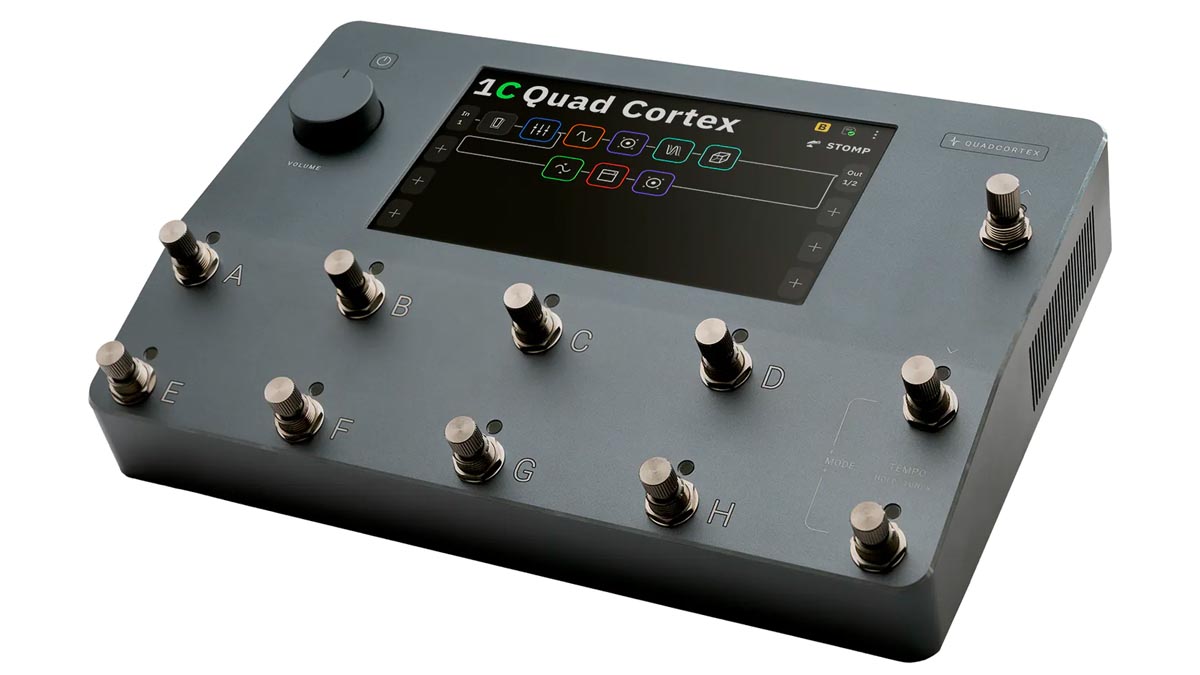
Connectivity is comprehensive (see the spec chart for details), and the guitar and bass amp emulations include a wide variety of the most popular contestants – subtly renamed renditions of Marshalls, Dumbles, Friedmans, Mesas, Soldanos, Voxes, Fenders, Ampegs, and so on, plus a range of creative composites.
Third-party IRs can quickly bulk up the already respectable cabinet selection, and the effects include all the basic building blocks you’d expect.
All that said, the Neural Capture function is about as easy to use as one could hope and allows you to capture not only your own amps, cabs, and pedals but also those of other users. For that matter, Neural DSP has set up a cloud app for users to share personal presets.
I tested the Quad Cortex with a Gibson 1958 Les Paul Reissue, a K-Line Springfield (with three single-coil Strat pickups), and a Novo Serus J with P-90s. Speakers included a pair of Mackie HR824 studio monitors for recording and a portable powered PA rig. The unit immediately delivered appealing and expressive sounds and was extremely easy to use in the process.
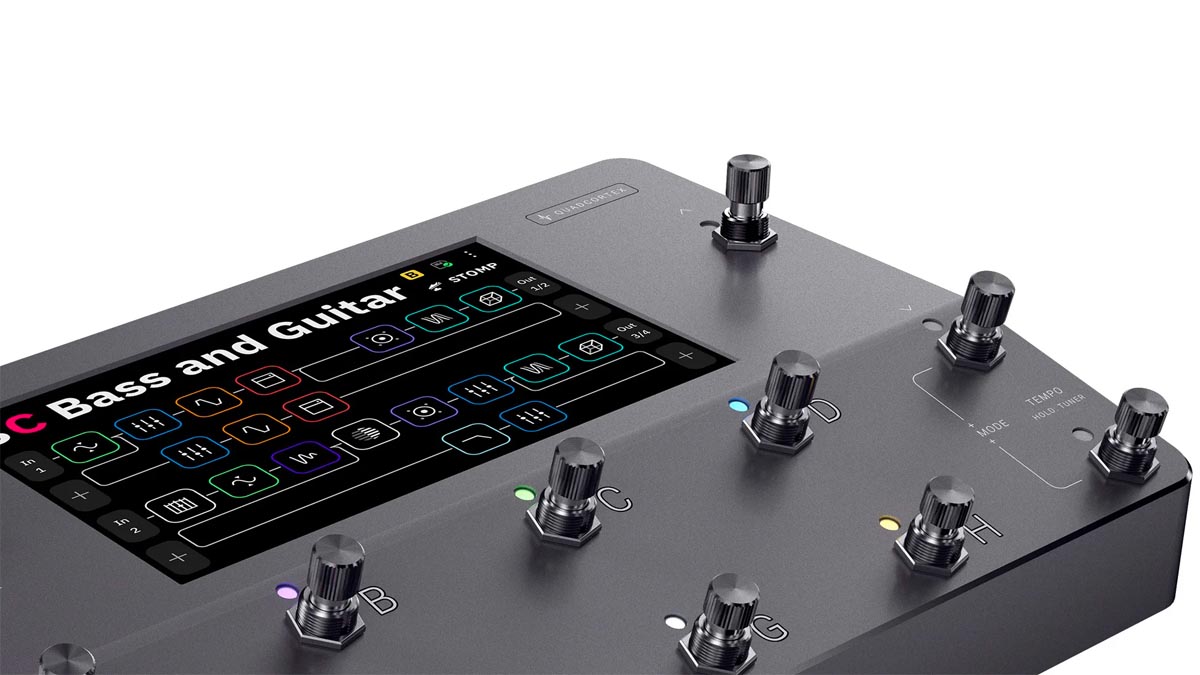
Deep into 2021, we’re way beyond discussing whether the better modeling products sound like real amps, so there’s little point of making any good/better/best comparisons on the sonic front. Often the best results require some digging into the presets and tweaking several parameters by ear, which I certainly did, but I also found many of the factory slots extremely pleasing just as they sat.
Overall, the unit’s DSP presented a “bigness” of soundscape, plenty of air and depth around the notes, and excellent dynamics that enabled a great playing feel and superb touch sensitivity.
The results never left me thinking, Okay, but if I plugged into a real Plexi..., the way such adventures did 20 or even 10 years ago. Neural DSP has predisposed several of the presets, and much of the marketing so far, to the metal and heavy-rock crowd, but don’t think for a moment that it’s limited to those genres.
It does ’60s classic-rock crunch, chimey AC30 jangle, glassy blackface-combo bite and twang, and much more. It’s really a heady all-rounder, and the sky’s the limit once you kick in the Neural Capture capabilities.
Some might feel the Quad Cortex’s effects selection is a little lacking alongside the Line 6 or Fractal offerings, but there’s more than enough to get the job done onstage, and in the studio most home recordists have plenty more at their fingertips anyway.
For pure amp tones, though, a long stint of A/B’ing against my go-to Fractal Axe-FX III proved the Quad Cortex easily able to punch above its weight, and I occasionally found it winning out where I hadn’t expected it to.
That’s pretty impressive when you consider that it’s really more competition for the smaller Fractal FM3 floor unit (which is the same price once you add the external FC6 foot controller, which has just six foot switches) or the slightly more expensive Line 6 Helix LT (with touch screen).
From any angle, the Quad Cortex is a clever, feature-packed, well-built, and great-sounding unit. What’s more, it’s truly fun and inspiring to play and easy to use. It promises to be a strong contender in this market, and earns an Editors’ Pick Award for its achievement.
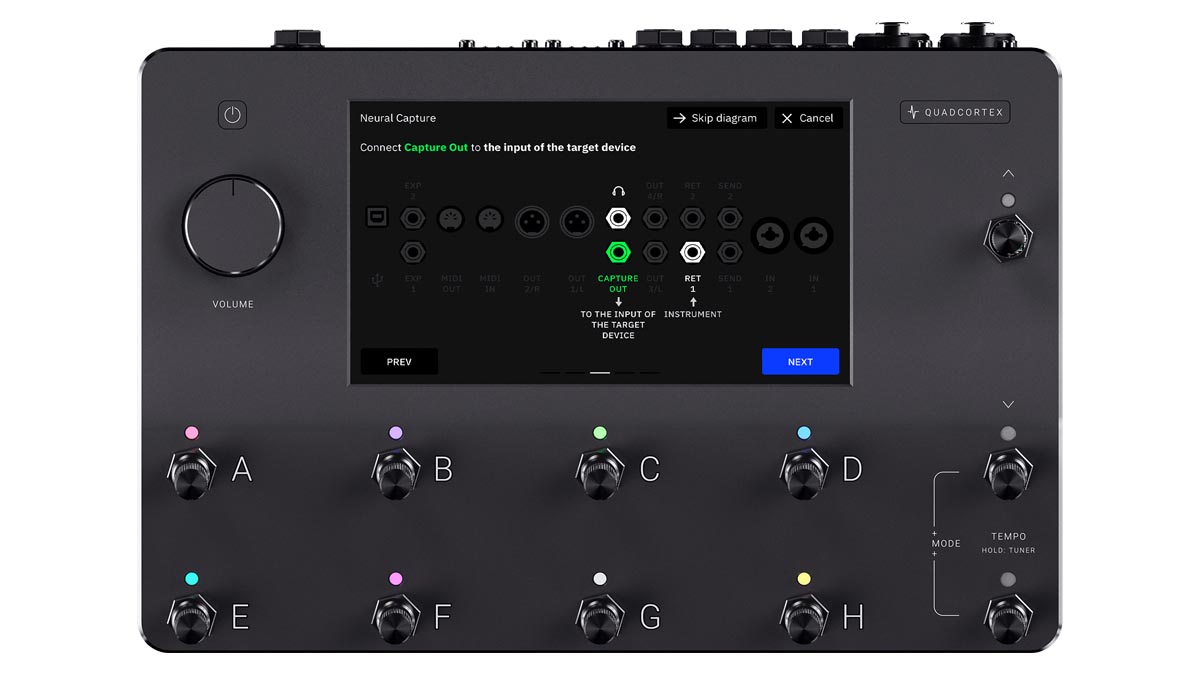
Specifications
- PRICE: $1,599 list/street
- CONTROLS: Volume, 11 dual-function foot-switch/rotary controls, touch-screen interface. DSP 2GHz Quad-Core SHARC processor
- CONNECTIVITY: Dual inputs (both XLR and ¼” TS/TRS), FX loop sends/returns 1 and 2 (which can be repurposed for up to four inputs and alternative monitoring), four outputs (two on XLR, two on balanced ¼” TS/TRS), MIDI in and thru, two expression pedal jacks, USB jack, Neural Capture out, WiFi
- FEATURES: Neural Capture (amp, cab and, pedal capturing), full functionality as a stand-alone Class 2.0 8 in/8 out low-latency USB audio interface
- WEIGHT: 4.2 lbs
- BUILT: Finland
- CONTACT: Neural DSP
Dave Hunter is a writer and consulting editor for Guitar Player magazine. His prolific output as author includes Fender 75 Years, The Guitar Amp Handbook, The British Amp Invasion, Ultimate Star Guitars, Guitar Effects Pedals, The Guitar Pickup Handbook, The Fender Telecaster and several other titles. Hunter is a former editor of The Guitar Magazine (UK), and a contributor to Vintage Guitar, Premier Guitar, The Connoisseur and other publications. A contributing essayist to the United States Library of Congress National Recording Preservation Board’s Permanent Archive, he lives in Kittery, ME, with his wife and their two children and fronts the bands A Different Engine and The Stereo Field.
A gigantic $360 off Positive Grid's celebrated BIAS amp sim software may have just put the nail in the coffin of my beloved valve combo
"Let’s take acoustic-electric amplification to its ultimate realization." How to make an acoustic amp shimmer like a vintage Fender, smolder like a Dumble or scream like a Marshall
